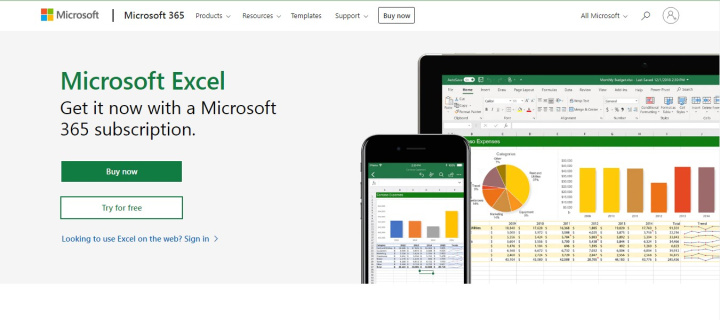History of Spreadsheets: From the Past to the Present
The development of any business is impossible without clear planning, for which it is necessary to have operational, accurate and easily perceived information. Spreadsheets help organize it all. From our article you will find out when and how they appeared, as well as who needs them and why.
Content:
1. What are spreadsheets
2. How to use spreadsheets
3. The history of spreadsheets
4. Spreadsheets today
5. Spreadsheet alternatives
6. Advantages of spreadsheets
7. Disadvantages of spreadsheets
8. Summing up
What are spreadsheets
A spreadsheet is a computer program that helps organize, analyze and store data in a tabular format, and automate calculations. This tool was developed to replace the paper spreadsheets widely used by accountants and bring them to a digital, more modern level.
Most of the calculations (especially in the field of accounting) are done in a spreadsheet format. Remember what the cost estimate, payroll, financial balance, payment from the utility provider look like. With the advent of spreadsheets, it has become easy and simple to solve those computational tasks that previously required the user at least basic knowledge of programming.
The computer program processes the data in the cells of the table. Each of them can contain not only numbers, but also text, as well as results obtained as a result of applying formulas. The latter automatically calculate and display values by interacting with the contents of the cells. With their help, you can quickly add, subtract, multiply a large number of numbers at once, compare them, determine the arithmetic mean, find the largest and smallest indicator, and more.
Each user of the spreadsheet has the ability to customize the values they save and see how the changes they make affect the result. This option is especially useful for performing “if” analysis, since the speed of the study in this case increases significantly compared to manual calculations. In addition to the standard set of arithmetic operations (addition, subtraction, multiplication and division), modern spreadsheet programs offer functions that allow you to perform statistical and financial operations. For example, you can calculate the standard deviation or net present value if you pre-program the desired function in the formula. They can also handle more specific tasks, such as turning text into numbers.

Some still believe that a spreadsheet is a simple sheet marked up into columns and rows, which can be easily “drawn” in the same MS Word document. This opinion is erroneous, because in fact it is a really powerful tool that allows you to perform complex calculations and thereby simplify the solution of problems in various fields.
How to use spreadsheets
Spreadsheets have replaced paper tables in all areas of our lives. Initially, they were developed for solving problems only in accounting, but today they are widely used wherever you need to create, sort and use lists in a tabular format: from a kindergarten to a large corporation.
A spreadsheet processor as part of an automated information system is actively used at manufacturing enterprises: data on order fulfillment, the amount of raw materials, equipment status, etc. are entered there.
In the world of business, where information about products, companies, banking data is updated every minute, it is simply impossible to do without spreadsheets and special programs for them. Constant modernization of already created software and the emergence of new ones greatly simplifies working with it and increases its accessibility for users even with a basic level of computer literacy.
Spreadsheets are an indispensable tool not only for accountants, but also for businessmen, merchandisers, economists and representatives of other professions. They make it possible to easily and simply, without undergoing special training, perform even the most complex calculations, simulate situations, and more. In essence, it is a powerful calculator with a huge number of valuable features and capabilities that greatly increase the efficiency of their user's work.

The history of spreadsheets
The idea of the spreadsheet belongs to the American scientist Richard Mattesich, who in 1961 published his study "Budgeting Models and System Simulation". In 1970, the concept he proposed was supplemented by the Canadians Rene Pardo and Remy Landau. They filed an application with the patent organization to officially document the authorship of the algorithm they developed to automatically calculate the natural order of spreadsheets. The institution rejected it, but the authors did not give up and sued the office. As a result, they managed to achieve a decision in their favor — a patent was received.
René Pardo and Remy Landau created the LANPAR (LANguage for Programming Arrays at Random) program in the summer of 1969 after graduating from Harvard University. It allowed arbitrary programming of entire arrays of data. LANPAR was used by the American telecommunications company AT & T, the Canadian telecommunications company Bell Canada and 18 other telephone companies in Canada, as well as the automobile concern General Motors (USA). With its help, local and national budgets were drawn up.
VisiCalc
If we consider the spreadsheet as a separate category of software, its "parent" is considered to be the American programmer Daniel Bricklin, who, in tandem with his colleague and friend Bob Frankston, created the VisiCalc program in 1979. The spreadsheet was designed for the Apple II personal computer. By the way, it was thanks to her that this PC became extremely popular, turning from a hobby for techies into a common and sought-after business tool.
After the success of the "apple" version in 1981, VisiCalc was introduced into 8-bit computers IBM PC, Atari, Commodore PET, TRS-80. Thus, in the early 1980s, the concept of spreadsheets became widely known, and VisiCalc became the first of them. It combines the core functionality of spreadsheet software with an interactive WYSIWYG interface, automated recalculation, formula and status bars, range copying with absolute and relative references, and building formulas by selecting specific reference cells. PC World magazine then wrote about VisiCalc as the first spreadsheet, overlooking that it had a predecessor — LANPAR.


In an interview, Daniel Bricklin told how he got the idea to create VisiCalc. In the classroom at the university, he watched the professor draw a table on the blackboard, where he entered the results of the calculations. When an error was discovered in the calculations, the teacher had to erase and re-enter the contents of several lines for a long time. This gave young Bricklin the idea that this process could be replicated on a computer. The board in this case served as a model that demonstrated the results of the basic formulas. Thus, the first VisiCalc spreadsheet was born.
SuperCalc
SuperCalc is a spreadsheet developed and introduced by Sorcim in 1980. First included in the CP/M operating system software package for the Osborne 1 portable microcomputer.
SuperCalc appeared as a competitor to VisiCalc. In late 1980, the creator of the first commercially successful portable computer, Adam Osborne, was looking for someone to sell spreadsheets for his brainchild, Osborne 1. At first, he wanted to acquire the rights to VisiCalc, but was refused. Then he asked Sorcim to make a table for him that could compete with VisiCalc. This request was granted, and Gary Baleisen took over the development. The novelty cost Osborne $ 20,000. The product presentation was a success. As a result, SuperCalc was bundled with the Osborne 1 computer as part of its software, and also sold separately for $295. In 1982, this spreadsheet was ported to MS-DOS.
Lotus 1-2-3
The popularity of the IBM PC grew slowly after its release in August 1981. The main reason: most of the programs used for it were "non-native". Created in November 1982, the Lotus 1-2-3 program helped to radically change this situation. It was written specifically for the IBM PC, so it had excellent performance. The success of Lotus 1-2-3 sparked a boom in sales of the IBM PC. Users were enticed by high fault tolerance as well as significant speed and graphics improvements. By these parameters, VisiCalc on the Apple II now lagged behind.
Lotus 1-2-3 soon ousted VisiCalc from the spreadsheet market. For several years it held the status of the most requested spreadsheet for MS-DOS.
Many are interested in why the numbers “1-2-3” appear in the name of the program. The answer is simple. The developer so designated the number of elements of which it consisted: tables, graphs and the main functionality of the database.
Microsoft Excel
Microsoft developed the first version of Excel for Macintosh personal computers and released it at the end of September 1985. For the Windows operating system, it appeared later — in November 1987. For some reason, Lotus was in no hurry to release spreadsheets for Windows, and this made it possible for Excel to bypass the competitor in terms of sales since 1988. Thus, Microsoft became the leading software developer. When Lotus finally unveiled its product for Windows, Microsoft was already hard at work building the entire Office package. In 1995, Excel spreadsheets took a leading position in the software market in this category, finally displacing Lotus 1-2-3 from there. In 2013, Lotus 1-2-3 was officially discontinued by IBM.

Excel is the first spreadsheet processor that gave the user the opportunity to adjust the "appearance" of the table right in the process of working with it: change the appearance of cells, symbols and font. It also implemented the so-called smart cell recalculation for the first time. The essence of the method was to update only those that depend on the changed ones. Previously, all cells in spreadsheets were automatically recalculated. This procedure was performed after each new change (if the table was large, it took time) or after a user command (the remaining values that were not recalculated could be confusing).
Today, Excel consistently holds a leading position in the spreadsheet market. And with data capture evolving every day you can now inegrate, analyze and use data from your spreadsheets faster than ever.
Spreadsheets today
One of the most popular and in-demand spreadsheet processors in the world today is MS Excel. The program is included in the Microsoft Office package. Microsoft Excel is a program that efficiently manages spreadsheets. The main tasks for which it is commonly used are: computing, organizing and analyzing data. It helps to draw up elementary accounts, plan a family budget, as well as make complex 3D diagrams and maintain full-fledged accounting for a company.
The Excel workspace is represented by sheets. A set of such sheets is called a book. When the program starts, the user sees the first sheet of the book that opens by default on the screen. Its standard name is "Book1", but you can change it if necessary. The sheet consists of columns and rows (it can fit a maximum of 256 columns and 65,536 rows). Each column is designated by a letter of the English alphabet, while the rows are simply numbered. A cell is formed by the intersection of a row and a column and automatically receives its own address (for example, a cell located at the “crossroads” of row 1 and column A has address A1). The file containing Excel workbooks has the .xls extension.

Excel developers have found the very middle ground: a fairly wide functionality combined with maximum accessibility for the average user. This allowed the program to gain high popularity in a short time. Today, Excel consistently holds a leading position in the spreadsheet market.
Spreadsheet alternatives
The success of the Microsoft Excel program constantly spurs other developers to come up with something that, if not bypass it in popularity, then at least compete with it. Throughout the history of Microsoft Excel, several companies have made several attempts to enter the spreadsheet market with software based on completely different paradigms. Lotus did it best. The Lotus Improv program was in demand in the financial sector. Its powerful potential in data mining commands respect even today.
Microsoft Excel is by far one of the best spreadsheet programs out there, but it's not without its flaws. Chief among them is cost. Fortunately, today there are plenty of free and more affordable alternatives that do the job just as well.
Advantages of spreadsheets
Among the main advantages are:
- Availability. The vast majority of those who work with spreadsheets in Excel today have not completed special training courses. Maximum — a brief briefing on the program menu from a colleague or friend. This is a huge advantage compared to, for example, the C++ programming language, which is unlikely to be mastered by an average user who is far from IT, even in a month.
- Openness and static. These qualities greatly simplify the correction of errors. The main difficulty in finding errors is to find the moment when the failure started. In other programs, you would have to “step back” all the time, undoing everything up to where the error occurred. You don't need to do this in spreadsheets. The most important thing here is to find the first cell with incorrect data and correct them. Everything else will pull up automatically.
- Independence. The user only sets the formula, and the system automatically performs the calculations. This concept is at the heart of all spreadsheets.
Disadvantages of spreadsheets
The cons are:
- Weak structured data model. In tables, it is represented by a 3-dimensional cell array. Of course, this is better than text completely devoid of any structure in the Notepad text editor, but also significantly worse, for example, serious typing in Java or normalization of the structure of a relational database. However, Java development services can still help in this case by going to an offshore software development company. You can find the necessary specialists in the neighborhood or in another country - both scenarios would still be considered software outsourcing, which in the end will help you in normalizing the relational database structure. To put it more simply, any cell can contain data of any type. There is no way to know in advance what will happen in conditional cell E5. The relationship between different tables is implicitly stored in the criteria of a function called VLOOKUP and is inevitably broken if a column is accidentally added. This is what causes most of the errors.
- High level of redundancy. IT developers try to follow the DRY principle (an abbreviation for "Don't repeat yourself", which means "do not repeat yourself"). As a rule, they write the logic once, give it a specific name (it can be any function), and then refer to it when necessary. But in tables like Excel, the user simply copies ready-made formulas. At first it seems that it is very convenient, but as a result, it is then difficult to figure out exactly where they are used. Making even minimal changes to already entered data leads to the need to copy formulas again. This makes the technical support and development of spreadsheet software extremely difficult.
- Non-interactive interface. You can not change the way data is displayed in dynamics, as well as programming operations that would then be performed with a single button.
Summing up
Today, almost every company or organization is faced with the need to process, store, structure and analyze huge amounts of data. Spreadsheets help to solve all these tasks quickly and easily. The relative ease of working with them turns complex and cumbersome processes into routine activities. A wide range of programs in this category presented on the software market allows you to satisfy the needs and wishes of almost any user.
ApiX-Drive is a universal tool that will quickly streamline any workflow, freeing you from routine and possible financial losses. Try ApiX-Drive in action and see how useful it is for you personally. In the meantime, you are setting up connections between systems, think about where you are investing your free time, because now you will have much more of it.

